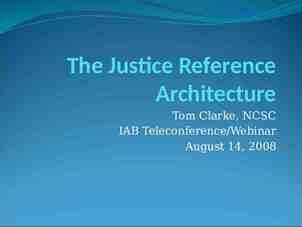Long- versus Short-Term Orientation in 10 minutes Geert Hofstede
8 Slides49.98 KB
Long- versus Short-Term Orientation in 10 minutes Geert Hofstede January 2015
Origin of the term “long- versus short-term orientation” Coined by Hofstede in 1991 for a fifth dimension of differences between national societies Based on answers of student samples from 23 societies around 1985 to the Chinese Value Survey (CVS), developed by Michael H. Bond from suggestions by Chinese scholars Replicated and extended in 2010 by Michael Minkov based on 1995-2004 World Values Survey (WVS) data from representative samples of the population in 93 societies
Long/Short Term Orientation as a societal culture dimension Long-Term Orientation stands for the fostering in a society of pragmatic virtues oriented to future rewards, in particular perseverance, thrift, and adapting to changing circumstances Its opposite pole, Short-Term Orientation, stands for the fostering in a society of virtues related to the past and the present, such as national pride, respect for tradition, preservation of face, and fulfilling social obligations 3
Long-Term Oriented societies Good and evil are relative Which norms apply depends on the situation The superior person adapts to the circumstances We should be humble about ourselves We want to learn from other countries Traditions can be changed Opposing truths can be integrated Common sense and choosing the middle way Short-Term Oriented societies Good and evil are absolute Fixed norms apply always, whatever the circumstances The superior person is always the same We seek positive information about ourselves We are proud of our own country Traditions are sacrosanct Truth A always excludes its opposite B Religious and ideological fundamentalisms
How are long- and short term orientation measured? There is no absolute standard for L/S orientation What we can measure is differences between societies The position of societies relative to each other is expressed in a Long-Term Orientation Index score (LTO) LTO values have been plotted on a scale from 0 to 100; scores close to 0 stand for a shorter, scores close to 100 for a longer term orientation
Some Long Term Orientation (LTO) scores, out of 93 High 88 Japan 87 China 83 Germany 81 Russia 67 Netherlands 63 France 61 Italy 53 Sweden Low 51 Britain 51 India 38 Israel 26 U.S.A. 24 Mexico 21 Australia 13 Nigeria 07 Egypt
Some examples of what these LTO scores correlate with Long Term Oriented societies Secondary school students perform well at mathematics Secondary school students underrate own math results Large savings quote, funds available for investment Companies seek market share, long-term profits Investors prefer family business and real estate In poor countries, faster economic growth Short Term Oriented societies Secondary school students perform poorly at mathematics Secondary school students overrate own math results Small savings quote, little money for investment Companies report quarterly results, stress bottom line Investors prefer shares and mutual funds In poor countries, slower economic growth
Don’t the LTO scores change over time ? The scores reflect values transferred from parents to children; these values were already found in 15-year olds; values acquired in childhood rarely change in later life Research by Sjoerd Beugelsdijk comparing answers to the same questions by two successive generations 30 years apart showed no worldwide shift and no changes in the position of countries Global information systems do affect private habits and business practices, but the way they do so varies between societies according to pre-existing and stable societal values













